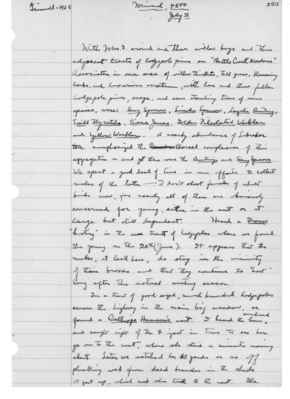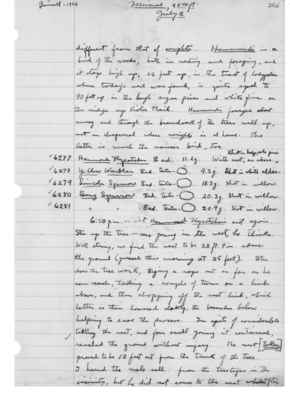Pages That Mention Lincoln's Sparrow
1925: Joseph Grinnell's field notes
S2 Page 60
Collector: Grinnell - 1925 Location: Mineral, 4800 Date: July 2 Page Number: 2513
With Mrs. G. around and thru [sic] willow bogs and thru [sic] adjacent tracts of lodgepole pines on "Battle Creek Meadows." Associates in one area of willow thickets, tall grass, blossoming herbs, and luxurious verotrum, with here and there fallen lodgepole pines, snags, and some standing trees of same species, were: Song Sparrow, Lincoln Sparrow, Lazuli Bunting, Traill Flycatcher, Sierra Junco, Golden Pileolated Warbler and Yellow Warbler. A nearby abundance of Labrador tea emphasized the Canadian Boreal complexion of this aggregation - and yet there were the Buntings and Song Sparrows. We spent a good deal of time in our efforts to collect males of the latter - I don't shoot females of adult birds now, for really all of them are obviously concerned for young, either in the nest or at large but still dependent. Heard a Grouse "hooting" in the same tract of lodgepoles where we found the young on the 20th (June). It appears that the males, at least here, do stay in the vicinity of their broods and that they continue to "hoot" long after the actual mating season.
In a tract of good-sized, much branched lodgepoles across the highway in the main big meadow, we found a Calliope Hummer's nest. I heard the hum overhead and caught sight of the female just in time to see her go on to the nest, where she staid a minute moving about. Later we watched her 50 yards or so off plucking web from dead branches in the shade 10 feet up, which web she took to the nest. She
S2 Page 62
Collector: Grinnell - 1925 Location: Mineral, 4800 ft. Date: July 2 Page Number: 2515
different from that of wrighti. Hammondi is a bird of the woods, both in nesting and foraging, and it stays high up; 25 feet up, in the tract of lodgepoles where today's nest was found, is quite equal to 90 feet up in the high sugar pines and white firs on the ridge up Viola Trail. Hammondi forages about among and through the branchwork of the trees well up, not in chaparral where wrighti is at home. The latter is much the noisier bird, too.
6277 Hammond Flycatcher [female symbol] ad. 11.2g. With nest, as above. ^Shot in lodgepole pine. 6278 Yellow Warbler [male symbol] ad. testes [testes illustration]. 9.2g. Shot in white alder. 6279 Lincoln Sparrow [male symbol] ad. testes [testes illustration]. 18.3g. Shot in willow. 6280 Song Sparrow [male symbol] ad. testes [testes illustration]. 20.3g. Shot in willow. 6281 [Song] [Sparrow] [male symbol] ad. testes [testes illustration]. 20.4g. Shot in willow.
6:50 p.m. - At Hammond Flycatcher's nest again. Stu up the tree - sees young in the nest, he thinks. With string, we find the nest to be 28 ft. 9 in. above the ground (guessed this morning at 25 feet). Stu does the tree work, tying a rope out as far as he can reach, taking a couple of turns on a limb above, and then chopping off the nest limb, which latter is then lowered slowly, the branches below helping to ease the process. In spite of considerable tilting the nest, and four small young it contained, reached the ground without injury. The nest [taken] proved to be 13 feet out from the trunk of the tree. I heard the male call from the treetops in the vicinity, but he did not come to the nest while after

